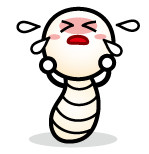- Indications of maggot therapy
- ・ Diabetic ulcers/gangrenes
- ・ Lower-extremity ulcers (ischemic, congested, or neurogenic)
- ・ Pressure ulcers
- ・ Infectious wounds (anti-drug bacteria, such as MRSA)
- ・ Other refractory wounds (postoperative wounds, traumatic wounds, burn
injuries, etc.)
- Contraindications of maggot therapy
- ・ Wounds with heavy irrepairable ischemia
- ・ Wounds with rapidly -progressing heeavy infection
- ・ Wounds with heavy osteomyelitis
- ・ Wounds with including an exposed digestive tract or blood vessel
- ・ Patients with heavy bleeding disorders
- ・ Wounds with that opening to deep inside ofto the body
- ・ Patients with sensitivity to maggots (at in past treatments)
- Side effects and countermeasures
- 1. Pain
- During the therapy some patients feel pain or skin irritation caused by
mechanical stimulation of the maggots and/or by PH increase in wounds.
Mild pain can generally be controlled by analgesics. If a patient feels
severe pain that cannot be controlled by analgesics, the maggots should
be removed immediately from the wound. The use of a biobag can also help
decrease pain during the therapy.
- 2. Bleeding
- Bleeding from wounds can occur if there are exposed blood vessels on them
or if patients have bleeding diathesis. Bleeding is generally limited to
a small amount of oozing, but if it is persistent, the maggots should be
removed and proper hemostatic treatment provided.
- 3. Fever
- Local inflammation on wounds can cause fever. If it cannot be controlled
by antipyretics, the maggots should be removed.
- 4. Progression of inflammation
- Maggots are applied to wounds to suppress inflammation (infection), but
in some cases inflammation grows worse, partly because the therapy changes
the balance of local pathogens. Some practitioners also suggest that the
condition of a wound might get worse due to progressed ischemia caused
by the stimulation of local chemical reactions.



